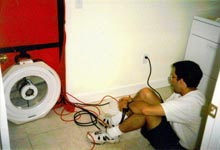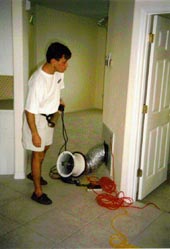
Duct and House Airtightness
 We used a Duct Blaster (The
Energy Conservatory) testing device to determine the relative leakage
in the return and supply sides of the duct systems in both homes. In the
Control home, the total CFM25 leakage of the duct system from outside the
conditioned space: 122 CFM25. Given its 2,425 square feet of conditioned
are, the duct leakage to outside is 0.05 cfm/ft2. This compares to the
0.03 cfm/ft2 proposed as a standard for utility new homes programs. In
the PVRES home, the total CFM25 leakage of the duct system from outside
the conditioned space was 50 CFM25 or about 0.021 cfm/ft2-- a low value.
In summary, we found that the tightness of the duct system of the Control
home was very average relative to most homes which we have tested. One
limitation of the tests, however, is that with the air handler operating,
all leaks are not the same. Ceiling penetrations close by the air handler
can bring air from the attic -- air that is super heated in the Control
home. The PVRES home with its interior duct system, on the other hand,
had as low a leakage to the outside of the building of any that have been
tested by FSEC. Moreover, any of the 50 cfm air that is unintentionally
drawn from the attic is being taken from a space that typically gets no
hotter than the outside ambient air temperature.
We used a Duct Blaster (The
Energy Conservatory) testing device to determine the relative leakage
in the return and supply sides of the duct systems in both homes. In the
Control home, the total CFM25 leakage of the duct system from outside the
conditioned space: 122 CFM25. Given its 2,425 square feet of conditioned
are, the duct leakage to outside is 0.05 cfm/ft2. This compares to the
0.03 cfm/ft2 proposed as a standard for utility new homes programs. In
the PVRES home, the total CFM25 leakage of the duct system from outside
the conditioned space was 50 CFM25 or about 0.021 cfm/ft2-- a low value.
In summary, we found that the tightness of the duct system of the Control
home was very average relative to most homes which we have tested. One
limitation of the tests, however, is that with the air handler operating,
all leaks are not the same. Ceiling penetrations close by the air handler
can bring air from the attic -- air that is super heated in the Control
home. The PVRES home with its interior duct system, on the other hand,
had as low a leakage to the outside of the building of any that have been
tested by FSEC. Moreover, any of the 50 cfm air that is unintentionally
drawn from the attic is being taken from a space that typically gets no
hotter than the outside ambient air temperature.
 We also used the Minneapolis
blower door to measure house tightness in both homes. For the Control
home the total overall building tightness of the control house was 2025CFM50
or 6.3 ACH50 with a house ELA of 95.2 square inches. The overall tightness
of the PVRES home was 1587 CFM50 or 4.9 ACH50 with a house ELA of 69.0
square inches. A
technical discussion of blower door data and its uses can be found
in an on-line publication available from LBNL. In both homes, we noted
that much of the leakage to the outside appears to be from the 30 recessed
lighting cans in the ceiling. For Central Florida's climate, a useful rule
of thumb to determine the house natural air infiltration rate is to divide
the house ACH at 50 pascals by 30. This indicates a typical natural air
change rate of about 0.16 ACH in the PVRES home and 0.21 ACH in the Control.
We also used the Minneapolis
blower door to measure house tightness in both homes. For the Control
home the total overall building tightness of the control house was 2025CFM50
or 6.3 ACH50 with a house ELA of 95.2 square inches. The overall tightness
of the PVRES home was 1587 CFM50 or 4.9 ACH50 with a house ELA of 69.0
square inches. A
technical discussion of blower door data and its uses can be found
in an on-line publication available from LBNL. In both homes, we noted
that much of the leakage to the outside appears to be from the 30 recessed
lighting cans in the ceiling. For Central Florida's climate, a useful rule
of thumb to determine the house natural air infiltration rate is to divide
the house ACH at 50 pascals by 30. This indicates a typical natural air
change rate of about 0.16 ACH in the PVRES home and 0.21 ACH in the Control.
Our test results indicate a fairly tight building envelope
for both homes, with the PVRES home somewhat better. However, the leakage
duct systems for the two homes show large differences, mainly due to the
interior duct system in the PVRES site. Moreover, thermography showed
that the leakage from the attic to the air handler at the Control site has
a potentially disproportionate impact on cooling efficiency.

![]()


